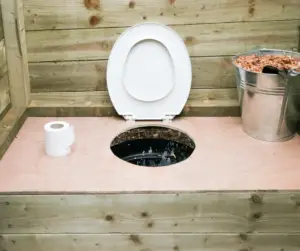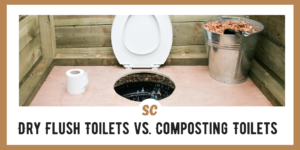Human waste always seems to be a taboo subject matter even though everyone produces it and they do so daily. In case the title of this article isn’t clear, the human waste I am referring to is the stuff that comes out of our bodies, urine, and feces.
This may not be a popular topic to have around the dinner table, but I assure you, the result of eating dinner is something you will have to deal with.
Why am I bringing this up? Because as a prepper you spend your time and resources to be prepared for bad times. And let me tell you if your toilet becomes inoperable due to some type of emergency, or for any reason for that matter, and you don’t have a backup plan, then you will be going through some bad times.
There are quite a few options available for taking care of human waste but today, this article will be focusing on dry flush toilets and composting toilets.
SKIP AHEAD
Dry Flush Toilets
A dry flush toilet works kind of like its name describes. It is a completely dry system, so no water is used during the “flushing” process and all the waste is essentially bagged up. To get a better understanding of how this works we need to take a closer look at the toilet, starting from the ground up.
How it Works
A dry flush toilet looks very similar to the toilet that most people have in their homes. In the bowl and back of the toilet, there are a few mechanical pieces and a battery.
A special bucket is then placed into the bowl and on top of a rotating gear. A large plastic bag, which is basically a garbage bag, lines the inside of the bucket and the inside of the bowl.
A round cartridge that is filled with what looks like aluminum foil is then placed on top of the bowl and the toilet seat comes down over that.
Now, it’s time to do your business, and no worries because a dry flush toilet can handle #1, #2, and toilet paper. After your business is concluded there is a small “flush” button that is pressed down and held for a few seconds to activate the inner workings.
Air is either blown in or sucked out to move the waste to the bottom of the foil material. The gear then rotates the bucket which twists the sheeting to create a small bag of self-contained waste. Air in the bowl is once again adjusted to settle the new layer of aluminum sheet and the toilet is ready to be used again.
When the aluminum-looking foil runs out it’s time to dump the bucket. To do this simply remove the lid and empty the cartridge and pull out the large plastic bag containing all the waste.
How many “flushes” you get per cartridge will depend on the model but one cartridge can contain enough material for around fifteen uses.
Even though the toilet doesn’t use any water, it does need some electrical power. The toilet does not need to be attached to a dedicated outlet 24/7 but it does need to be plugged into a power source every few weeks to charge an internal battery.
Pros
- Portable
- Does not require any water
- Low odor
Cons
- Requires some electrical power
- Requires a supply of large plastic bags and cartridge refills
- Bagged waste needs to be disposed of properly
- Cost several hundred dollars
Composting Toilet
When it comes to composting toilets, there are several designs a person can choose from but for the sake of this article, I will be discussing the simplest and most affordable setup.
A composting toilet works by combining human waste with an organic medium such as sawdust, leaves, or pine tree needles. Within this mixture, decomposition occurs and the result is a composting material.
How it Works
A box is usually built in the spot where you want your toilet to be situated. A large hole is cut on top of the box and your choice of a toilet seat is placed over the hole. To have easier access to the inside of the box, the entire top of the box can be turned into a lid.
A container is then placed inside of the box underneath the hole to collect waste. Any durable container can be used but most people use a five-gallon bucket.

Once the bucket is in place some of the organic media is placed on the bottom. You can then go ahead and do your business on top of the medium.
When your business has been completed more organic material is placed on top of that. When the bucket is full it can be dumped outside into a composting pile.
However, some people will let the bucket sit outside, sealed for a few weeks to allow the material to decompose further before being dumped. If you take this route be sure to have plenty of extra buckets because some of them will be occupied for a while.
Pros
- Does not require any water
- Low odor
- Does not require any power
- Waste Is turned into usable compost
- Very affordable
- Portable
Cons
- The waste has to be dumped in a designated location
Dry Flush and Composting Toilets At a Glance
Below is a quick overview of the two toilets side by side.
| Dry Flush Toilet | Composting Toilet |
| No water used | No water used |
| Minimum power required | No power required |
| Portable | Portable |
| Has mechanical parts | No mechanical parts |
| Easy to install | Easy to install |
| Works off the grid (minimum power needed) | Works off the grid |
| Expensive | Very affordable |
Wrap Up
The dry flush toilet is nice in that each flush is self-contained after use but you will need access to a power source and extra supplies for the toilet.
A simple composting toilet will be much cheaper and does not need a power source or additional toilet supplies, other than the organic medium, but there will need to be an outdoor space available for the waste to be dumped.
The one that you choose is up to you but both the dry flush and the composting toilet appear to be viable options for preppers.
Let us know your thoughts or experiences by leaving a comment below. Thanks for reading and stay prepared.


